Post-war service and combat use of captured German 75–128 mm anti-tank guns
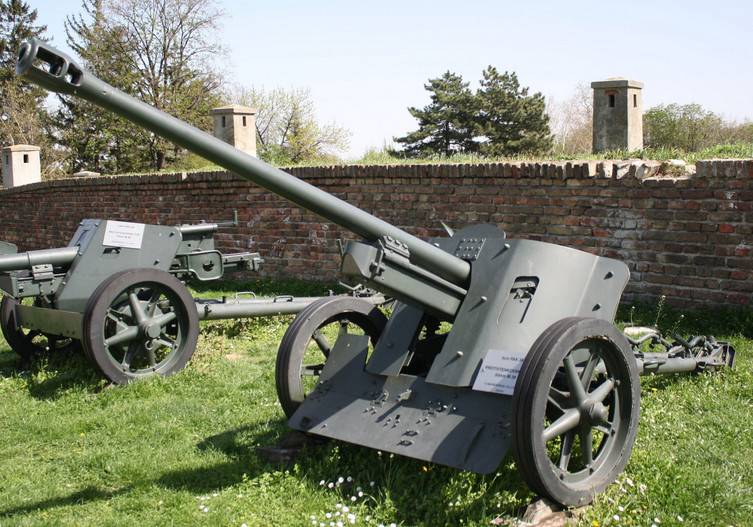
In the initial period of World War II, German 37–50 mm anti-tank guns were fully adequate for their purpose. But already at the end of 1941 it became clear that in order to reliably defeat medium and heavy tanks with anti-ballistic armor, more powerful 75 mm guns are required. Subsequently, this trend continued, which was associated both with the increase in the security of Soviet, American and British tanks, and with the desire to increase the effective firing range and the power of an armor-piercing projectile.
At the end of the war, very powerful 88-128 mm guns came into service, capable of reliably penetrating the frontal armor of the most heavily protected serial heavy tanks available in the USSR, USA and Great Britain.
However, large-caliber anti-tank artillery systems were very expensive to produce and limited in mobility. Relatively few of them were released, and they were unable to have a decisive influence on the course of hostilities.
In the post-war period, German anti-tank guns did not leave the scene; they were in service or in storage in a number of states. The last cases of their combat use were noted in the mid-1990s.
75 mm anti-tank guns
The best German anti-tank gun of the Second World War is the 7,5 cm Pak. 40, designed by specialists from Rheinmetall-Borsig AG based on the 5 cm Pak. 38.
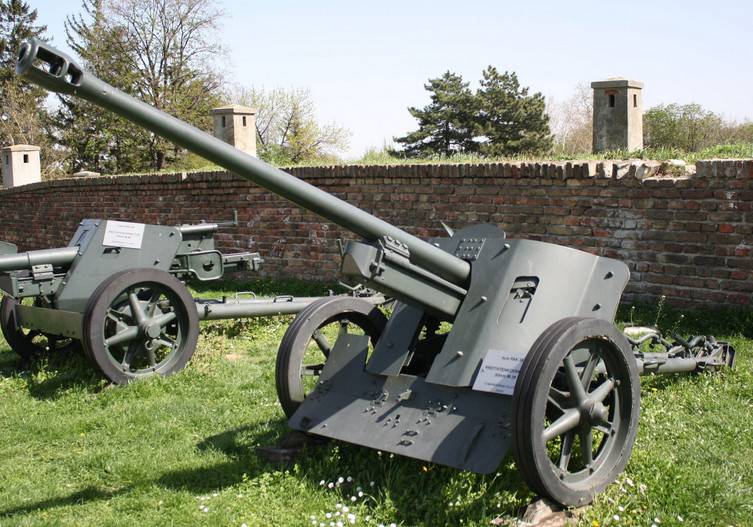
75 mm anti-tank guns 7,5 cm Pak. 40 on museum display
Although in Nazi Germany guns were created and adopted that had higher armor penetration, namely the 75-mm Pak. 40 in terms of its complex of combat and service-operational characteristics is recognized as the best German anti-tank artillery system used during the war.
This 75-mm gun was created and formally adopted by the Wehrmacht even before the attack on the USSR, but its launch into mass production was delayed for a long time. About 7,5 cm Pak. 40 was remembered at the end of 1941, when the German senior military-political leadership realized that the lightning war had failed.
The first batch of 15 guns entered service only in February 1942. However, the production rate grew rapidly, and by March 1945, more than 20 guns were delivered, some of them were used to arm tank destroyers. On March 000, 1, the troops had 1945 towed 4 mm Pak 695 guns. However, it should be noted that the Germans experienced a shortage of effective anti-tank artillery throughout the war.
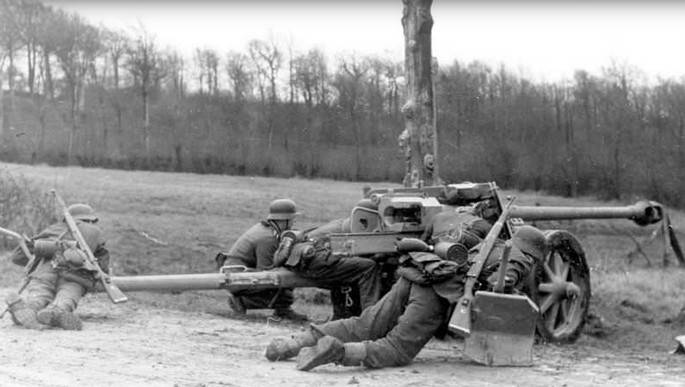
According to the staffing table approved in February 1943, the infantry division was entitled to 39 guns, but this was not always observed, and the 75 mm Pak 40 anti-tank guns were often replaced by other types of artillery systems.
For 75 mm caliber gun 7,5 cm Pak. 40 had very good armor penetration characteristics, which was largely due to the shot with a long cartridge case containing a significant powder charge. In addition to the caliber armor-piercing projectile, sub-caliber projectiles and cumulative grenades could be used to fire at armored vehicles.
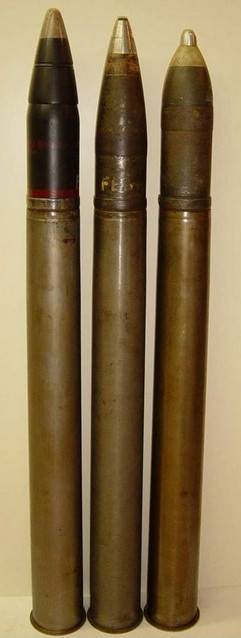
Shots for the 7,5 cm Pak anti-tank gun. 40
Armor-piercing projectile 7,5 cm Pzgr. 39 weighing 6,8 kg, leaving the barrel with an initial speed of 792 m/s, when hit at a right angle at a distance of 500, it could penetrate 110 mm armor; at a distance of 1 m, armor penetration reached 000 mm.
The 7,5 cm Pzgr. sub-caliber projectile had very high performance. 40. With a mass of 4,1 kg, it had an initial speed of 933 m/s, and penetrated 500 mm armor at a normal distance of 150 m. However, due to a shortage of tungsten, after 1943, rounds with sub-caliber shells practically disappeared from the ammunition load of German 75-mm anti-tank guns.
HEAT projectile 7,5 cm Gr. 38 Hl/B weighing 4,4 kg, from any distance, at a right angle, could penetrate 85 mm armor. The ammunition also included shots with 7,5 cm Sprgr high-explosive fragmentation grenades. 34. This grenade weighed 5,74 kg and contained 680 g of explosives.
The mass of the gun in firing position was 1 kg. Barrel length - 425 mm (3 calibers). Rate of fire – up to 450 rds/min. For towing 46 cm Pak. 15 it was necessary to use only mechanized traction; if there was a shortage of standard traction, captured tractors were used.
Main part 7,5 cm Pak. 40 that fought on the Eastern Front were lost on the battlefield, up to 500 guns became trophies of the Red Army.
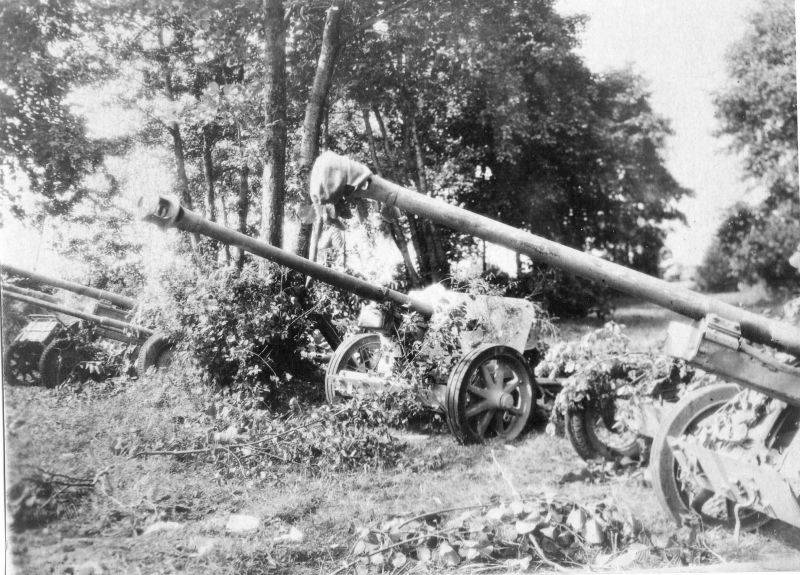
German anti-tank guns captured by Soviet troops during the battles for the liberation of Belarus
At the first stage, Soviet artillerymen used captured 7,5 cm Pak. 40 was supernumerary, but at the end of 1943, the Red Army began the formation of anti-tank fighter divisions armed with 75-mm German-made guns, which were significantly superior in armor penetration to the Soviet 76,2-mm ZiS-3 guns.
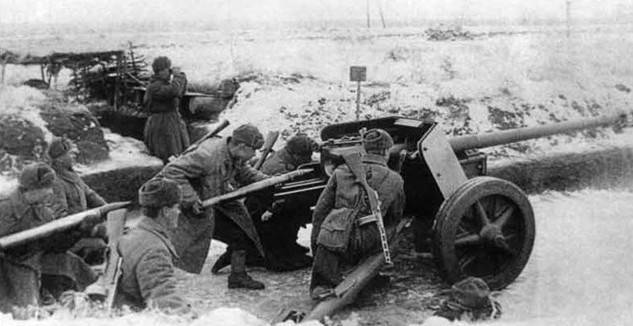
Captured 75 mm Pak gun. 40 could confidently fight German medium and heavy tanks at a range of up to 1 km. At the same time, when firing, it “buried” its coulters more strongly into the ground, as a result of which it was significantly inferior to the ZiS-3 in the ability to quickly change position or transfer fire.
In the second half of the 1940s, the 7,5 cm Pak was suitable for further use. 40 were put into storage in the USSR, where they remained for about 20 years.
75 mm Pak guns. 40 During World War II, Germany supplied to Hungary, Slovakia, Spain, Finland, Romania and Bulgaria. With the transition of the last three to the anti-Hitler coalition in 1944, the weapons available in the armed forces of these countries were used against the Germans.
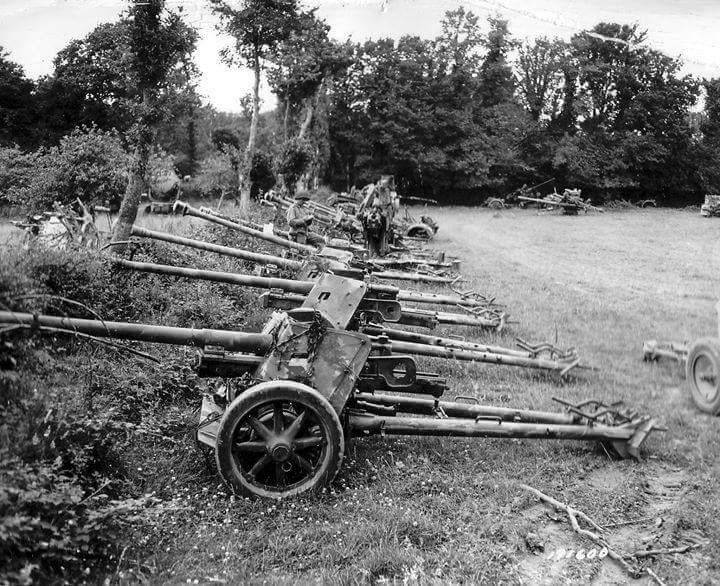
Anti-tank guns captured by the Allies in Normandy
In the post-war period, several hundred 7,5 cm Pak. 40 were in service in states that were occupied by the Nazis or were allies of the Third Reich. Thus, in Czechoslovakia, Yugoslavia and France, the production of shots for these guns was established. Operation of captured 75 mm Pak guns. 40 in Czechoslovakia, Spain and France continued until the first half of the 1960s.
At the end of the 75s, Czechoslovakia supplied a certain number of 1940-mm anti-tank guns to Israel, where they were in service with anti-tank units attached to infantry brigades.
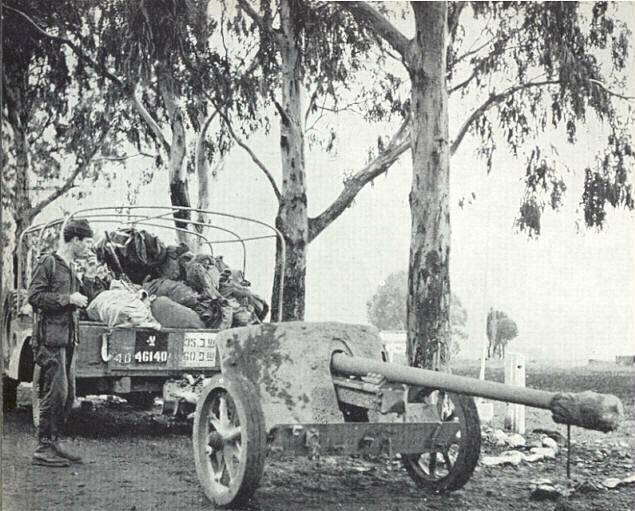
It is unknown how long the Israeli 7,5 cm Pak was in service; perhaps it lasted until 1967. But there is no information about the use of German-made guns in combat.
Much longer story 7,5 cm Pak. 40 was in Yugoslavia. As you know, the Yugoslav People's Army actively exploited a number of German weapons from the Second World War for several decades. Until the early 1970s, captured 75 mm guns made up a significant part of the Yugoslav anti-tank artillery, after which these guns were withdrawn into reserve.
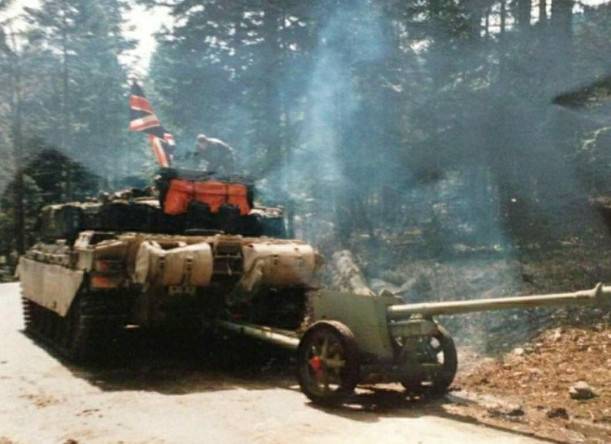
A British Challenger tank is towing a 7,5 cm Pak gun. 40, captured in 1996 in the Bosnian city of Drvar
Subsequently, 75 mm Pak guns. 40, taken from storage, were used in combat operations in the territory of the former Yugoslavia. Several such weapons were seized by foreign peacekeeping troops.
In 1959, the Democratic Republic of Vietnam received several dozen 7,5 cm Pak from the USSR. 40, which were in storage, and ammunition for them.
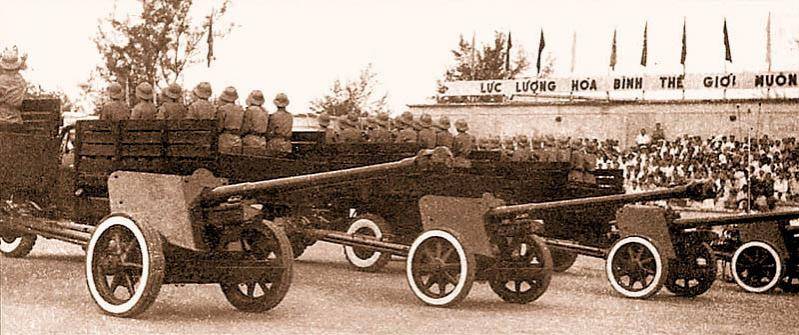
Anti-tank guns 7,5 cm Pak. 40 on parade in Hanoi
Guns 7,5 cm Pak. 40 in North Vietnam were sent to form anti-tank divisions, which was due to fear of aggression from the South using armored vehicles.
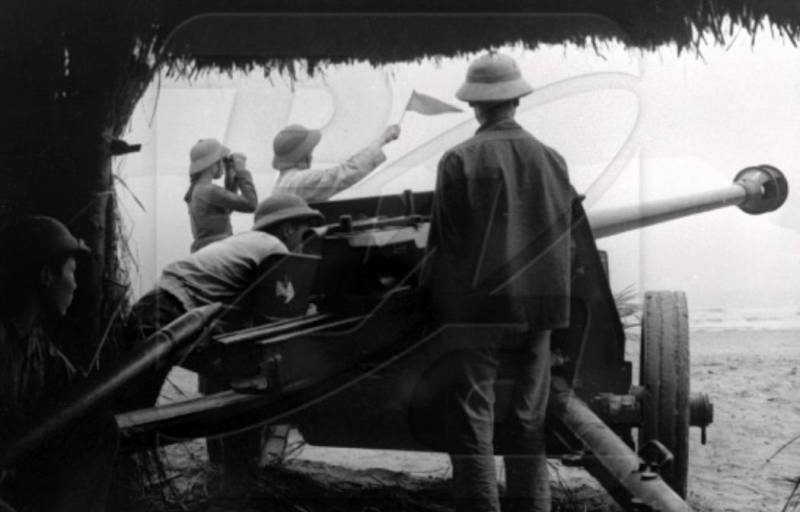
Later, 75 mm guns were placed in anti-landing fortifications on the coast, where they served until the early 1980s.
The shortage of anti-tank guns caused the armed forces of Nazi Germany to actively use artillery pieces captured in other countries.
After the occupation of France and Poland, the Germans received several thousand French-made 75-mm Canon de 75 mle 1897 (Mle. 1897) divisional guns and more than 7,5 million rounds for them. Gun Mle. 1897 was born in 1897, and was the first mass-produced rapid-fire gun equipped with recoil devices. But by the beginning of World War II, this artillery system was hopelessly outdated.
Initially, captured 75-mm cannons designated 7,5 cm FK231 (f) (French) and 7,5 cm FK97(p) (Polish) were used in their original form in artillery batteries assigned to second-line infantry units, as well as in coastal defense on the coasts of Norway and France.
At the end of 1941, due to the need to make up for the losses suffered by anti-tank artillery on the Eastern Front, and the lack of anti-tank guns capable of fighting tanks with anti-ballistic armor, the German command remembered the captured French divisional guns.
However, it was difficult to use these outdated “divisions” to fight tanks, even with an armor-piercing projectile in the ammunition load, due to the small horizontal guidance angle (6°) allowed by the single-beam carriage. The lack of suspension allowed towing at a speed of no more than 12 km/h. In addition, a cannon that could only be towed by horse-drawn vehicles was by that time an archaism.
German designers found a way out: the swinging part of the 75-mm French gun Mle. 1897 was added to the carriage of the German 50 mm anti-tank gun 5,0 cm Pak. 38 with sliding tubular frames and wheel travel, providing the possibility of towing with a mechanized traction. To reduce recoil, the barrel was equipped with a muzzle brake. The Franco-German "hybrid" was put into service under the designation 7,5 cm Pak. 97/38.
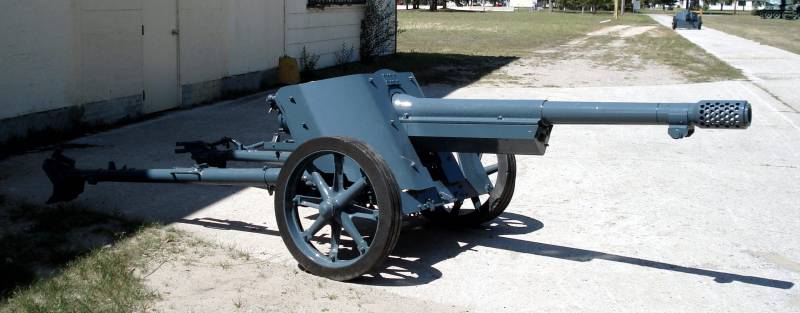
75 mm gun 7,5 cm Pak. 97/38 on display at the museum
The mass of the gun in firing position was 1 kg. Vertical aiming angles from −190° to +8°, in the horizontal plane – 25° to the right and left. The 30 mm Pak 75/97 gun retained the Mle piston breech. 38, which provided a rate of fire of 1897–10 rounds/min. The maximum range of a high-explosive fragmentation grenade is 12 m.
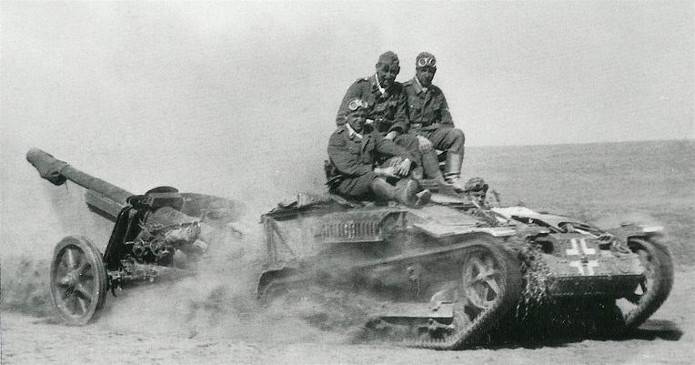
The gun could be towed by mechanical traction, for which various captured tractors were often used.
The shooting was carried out with unitary shots of German, French and Polish production. Captured high-explosive fragmentation rounds were used in their original form and converted into cumulative ones. In addition to the 75mm high-explosive fragmentation grenade rounds captured in France and Poland, the Germans fired about 2,8 million more shells.
An armor-piercing projectile weighing 6,8 kg left a barrel 2 mm long with an initial speed of 721 m/s, and at a distance of 570 m at an impact angle of 100° could penetrate 30 mm armor. Such armor penetration characteristics made it possible to reliably hit armored vehicles with bulletproof armor, but this was certainly not enough to confidently fight the T-61 and KV-34 tanks.
In connection with this, 7,5 cm Gr.38/97 Hl/A(f), 7,5 cm Gr.38/97 Hl/B(f) cumulative projectiles and 7,5 cm Gr cumulative tracer were introduced into the ammunition load. 97/38 Hl/C(f). Their initial speed was 450–470 m/s. The effective firing range at moving targets is up to 500 m. According to German data, cumulative shells, when hit at right angles, pierced 80–90 mm armor.
Production of 7,5 cm Pak. 97/38 began in February 1942 and lasted until July 1943. Moreover, the last 160 guns were manufactured on a 7,5 cm Pak gun carriage. 40, and they were designated 7,5 cm Pak. 97/40. Compared to 7,5 cm Pak. 97/38, the new artillery system became heavier (1 versus 425 kg), but the ballistic data and rate of fire remained the same.
In just a year and a half of serial production, 3 guns, converted from 712-mm French “divisions,” were delivered.
At the first stage, 7,5 cm Pak guns. 97/38 and 7,5 cm Pak. 97/40 went to anti-tank fighter divisions. But during combat use, it became clear that the French-German “artillery hybrids” did not fully meet the requirements of anti-tank defense.
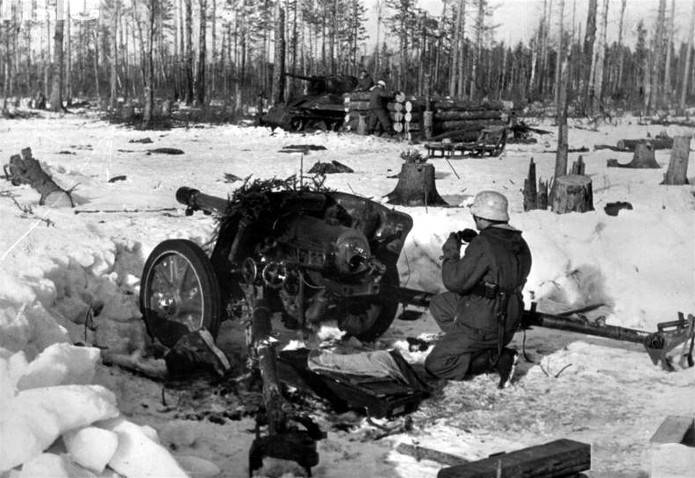
This was primarily due to the relatively low initial velocity of the projectiles, which negatively affected the direct shot range and shooting accuracy. Although German specialists managed to achieve almost maximum armor penetration for a 75-mm rotating cumulative projectile, this was often not enough to confidently overcome the frontal armor of the T-34 tank.
According to the capabilities of combating armored vehicles 7,5 cm Pak. 97/38 and 7,5 cm Pak. 97/40 were not much superior to the 75 mm infantry guns IG 37 and IG 42, but their weight in firing position was much greater.
In the summer of 1943, after the start of mass production of the 7,5 cm Pak. 40, most of the 75-mm French-German “hybrids” were removed from anti-tank divisions and transferred to field artillery, where they mainly fired at manpower and light wood-earth fortifications.
75-mm guns were placed in long-term fortified positions on the Atlantic Wall, and a significant part of them went to the Allies in good condition. In addition to the armed forces of Nazi Germany, the 7,5 cm Pak. 97/38 were delivered to Romania and Finland.
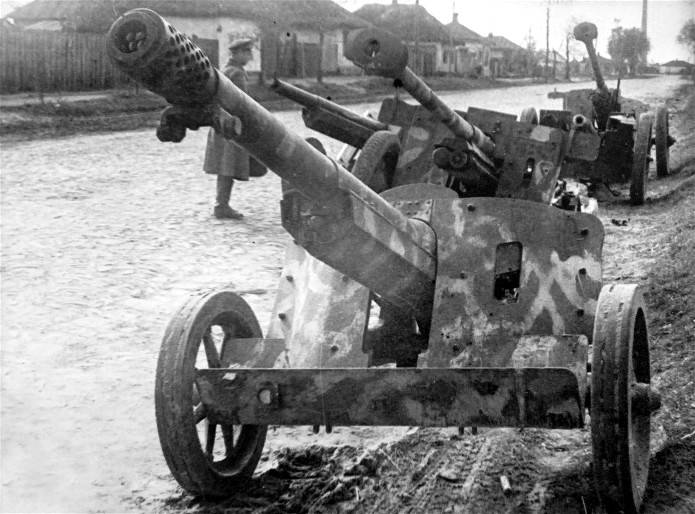
During the offensive operations of the Red Army, they managed to capture several hundred 7,5 cm Pak. 97/38 and 7,5 cm Pak. 97/40, and if ammunition was available, these guns were used against their former owners as part of the Soviet regimental and divisional artillery. Since there were no firing tables for them, captured 75-mm guns mainly fired at visually observed targets.
After the end of World War II, 75-mm French-German guns saw limited use in Romania and Finland for some time. In the 1950s–1960s, captured 7,5 cm Pak. The French used 97/38 during the fighting in Algeria and Indochina, which is apparently explained by the supply of barrels and ammunition for Canon de 75 mle 1897 divisional guns.
In Algeria, 75mm cannons fired at areas where rebels were spotted. In Vietnam, these guns were installed in the vicinity of military bases, and they were together with the 50 mm 5,0 cm Pak. 38 fired direct fire while repelling partisan attacks.
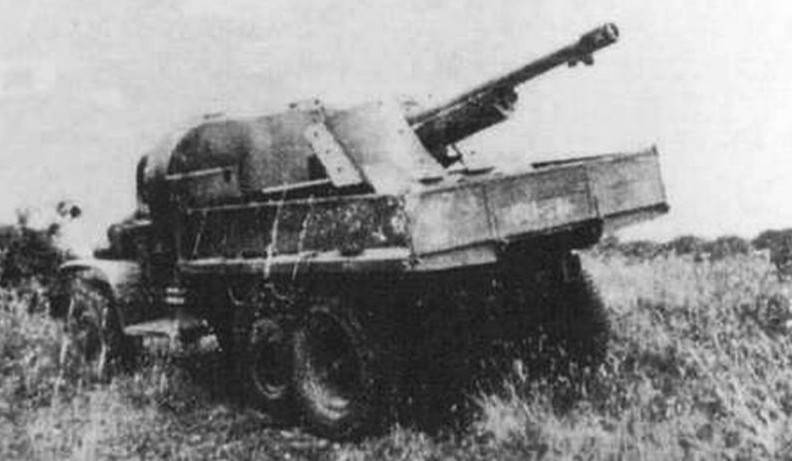
There is a photograph of the 7,5 cm Pak gun. 97/38, installed in the back of a three-axle truck. Such an improvised self-propelled gun was used as a means of fire reinforcement for infantry units.
88 mm anti-tank guns
After a collision with Soviet medium tanks T-28E and T-34, as well as with heavy KV-1 and KV-2, the enemy began to use 88-mm anti-aircraft guns in anti-tank defense, and shots were introduced into the ammunition load of standard 37-75-mm guns with sub-caliber shells.
In 1942, German experts predicted the emergence of new Soviet heavy tanks with even thicker armor, and therefore the need to create anti-tank artillery systems with a caliber of more than 75 mm became urgent. An important factor for this was the shortage of tungsten, which was then used as a material for the cores of sub-caliber projectiles. The construction of a more powerful weapon opened up the possibility of effectively hitting heavily armored targets with conventional steel armor-piercing shells.
In 1943, the 88-mm anti-tank gun 8,8 cm Pak entered service. 43, created by specialists from the Friedrich Krupp AG concern using the artillery part of the 8,8 cm Flak anti-aircraft gun. 41.
This gun, with a rate of fire of up to 10 rounds/min, demonstrated outstanding armor penetration performance. Armor-piercing projectile 8,8 cm Pzgr. 40/43 weighing 7,3 kg with an initial speed of 1 m/s, at a distance of 000 meters, penetrated 1-mm armor placed at an angle of 000°. The 190-mm gun could easily hit any production tank of that time from the frontal projection at all reasonable combat distances. The ammunition also included rounds with a cumulative 60 cm Gr grenade. 88/8,8 HI with armor penetration along the normal 38 mm. The effect of the 43 kg 110 cm Sprgr high-explosive fragmentation projectile turned out to be very effective. 9,4, containing 8,8 kg of TNT.
Initially, the artillery unit was transported on a biaxial “cart”, similar to that used on an anti-aircraft gun. If necessary, it was possible to shoot from wheels, but in this case the horizontal aiming sector was limited to 60°.
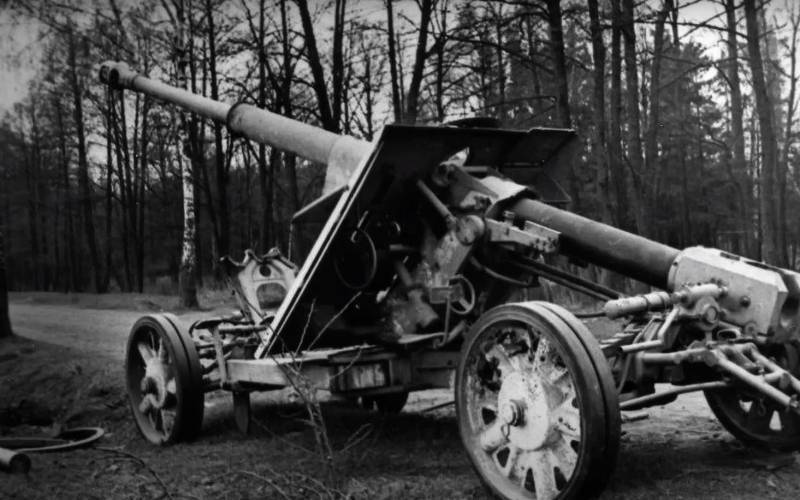
When transferred to the firing position, the jacks were used, after which two sets of transport wheels were removed, the gun was lowered onto a cross-shaped support and leveled in the horizontal plane. To prevent movement during firing, steel pins were driven into the ground through holes in the cross-shaped carriage.
An unusual feature for a field gun was the electric firing mechanism. Also new were emergency safeties built in to prevent a shot from being fired at a certain elevation angle at which the bolt could strike one of the platform legs during recoil.
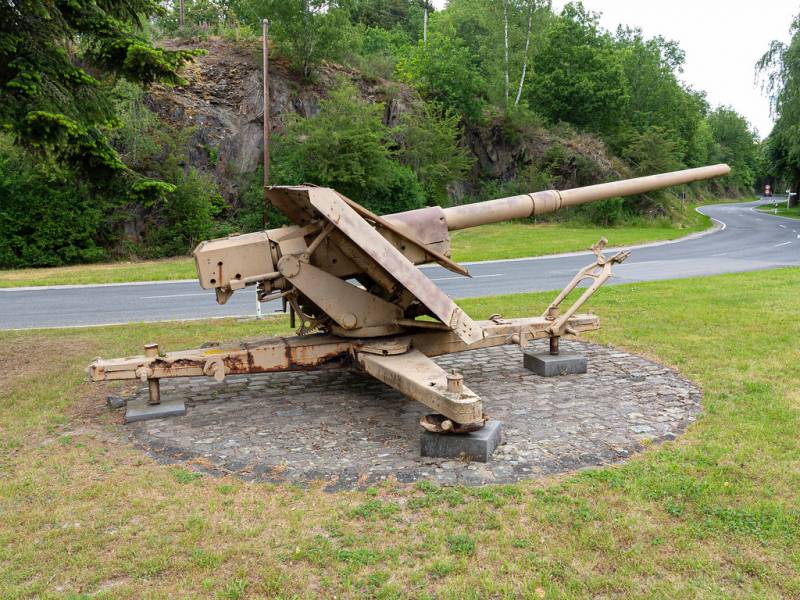
When transferred to the ground, it was possible to conduct circular fire. Vertical aiming angles: from −5 to +40°. The weight of the gun in the stowed position is 4 kg, in combat - 950 kg.
It is clear that an artillery system with such a carriage required great physical effort from the crew when transferring from the traveling position to the combat position and back. Excessive weight 8,8 cm Pak. 43 limited her mobility. To tow the 88 mm anti-tank gun, a powerful tractor was needed.
A gun known as the 8,8 cm Pak. 43/41, mounted on the carriage of a 105 mm leFH field howitzer. 18/40. The vertical aiming angles were: −8…+38°. Horizontal firing sector – 56°.

This modification became lighter, the weight in the stowed position was 4 kg, in the combat position - 400 kg. However, the reduction in mass was not so radical, and the crew still could not roll the gun on their own.
On modification 8,8 cm Pak. 43/41, a very advanced sight was installed that made it possible to destroy tanks at a range of more than 2 m; at such a distance, experienced gunners achieved a hit probability of more than 000%. Changes made to the bolt made it possible to fire 40 rounds/min, however, taking into account the fact that when firing a smoke and dust cloud formed in front of the gun, and the artillery shots were heavy, and the loaders quickly got tired, in reality the rate of fire did not exceed 15 rounds/min .
88 mm anti-tank guns made their debut on the battlefield in the second half of 1943, and their production continued until 1945. Originally 8,8 cm Pak. 43 armed specialized anti-tank divisions. At the end of 1944, guns began to enter service with artillery corps.
Due to the complexity of production, high metal consumption and cost, only 3 guns of the 502 cm Pak modifications were produced. 8,8 and 43 cm Pak. 8,8/43. As of January 41, 1, the troops had 1945 guns.
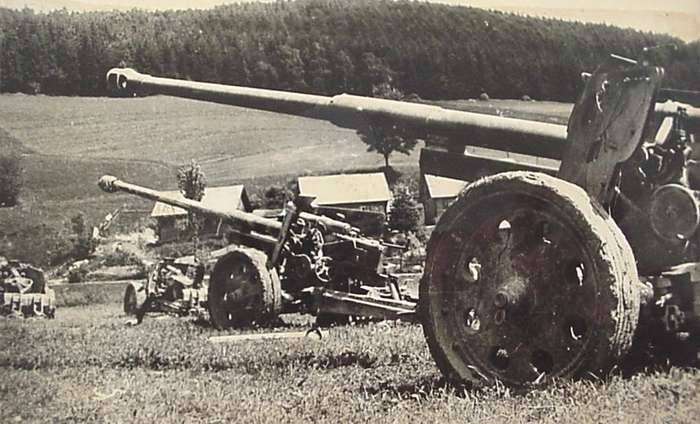
With very high armor penetration, firing range and accuracy, the operation and combat use of 88-mm anti-tank guns was not easy. Taking into account the fact that, due to their large mass, these guns could not quickly leave the firing position, in the event of a flanking by the enemy, it turned out to be impossible to quickly evacuate them. Due to its high silhouette and bulkiness, the 8,8 cm Pak. 43 and 8,8 cm Pak. 43/41 was difficult to camouflage on the ground.
It is now impossible to say how many 88-mm anti-tank guns the Red Army captured. But taking into account the fact that relatively few of them were released, we can talk about several dozen.
It must be said that 88-mm anti-tank guns were considered a valuable trophy. Armor penetration characteristics of Pak guns. 43 tanks allowed them to successfully fight all types of heavy German tanks and self-propelled artillery units. But at the final stage of the war, German armored vehicles were used mainly in defense, and did not often appear in front of our artillery positions.
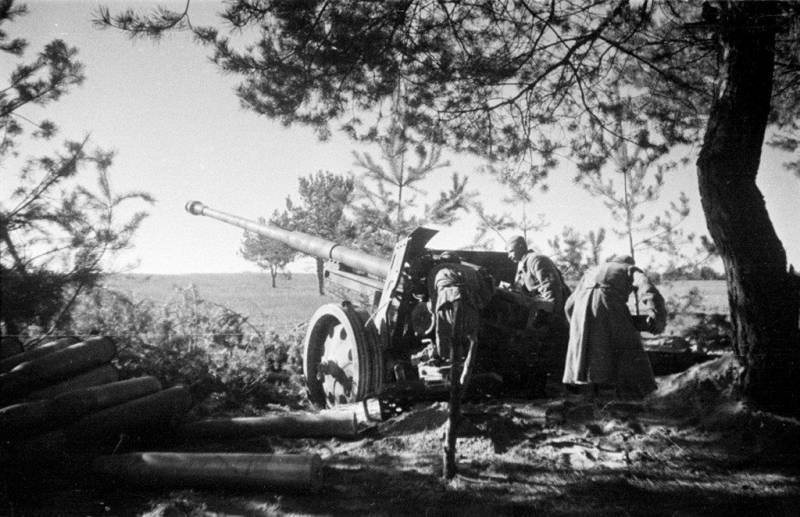
The firing range of an 88-mm high-explosive fragmentation grenade exceeded 15 km, and most often captured heavy anti-tank guns were involved in counter-battery combat or fired harassing fire at targets in the rear of the Germans.
However, captured 88-mm guns were not popular among the artillerymen of the Red Army. This was mainly due to the fact that transporting them and changing positions required a lot of effort.
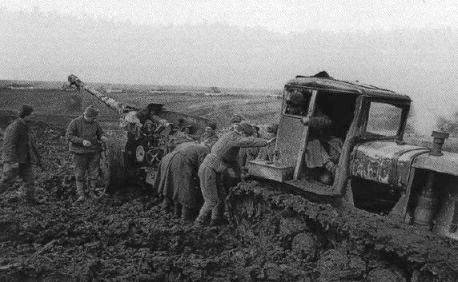
Even powerful tracked tractors could not always tow these artillery systems in muddy conditions.
Captured Pak anti-tank guns. 43 were subjected to field testing in the USSR in 1944. Soviet experts noted the excellent ballistic characteristics and perfect sights. The design was considered reliable, but overweight. In the post-war period, German 88-mm guns were used to determine the ballistic resistance of promising Soviet tanks.
The allies in the anti-Hitler coalition also had at their disposal a number of serviceable 88-mm guns, which they used to fire at German defenses.
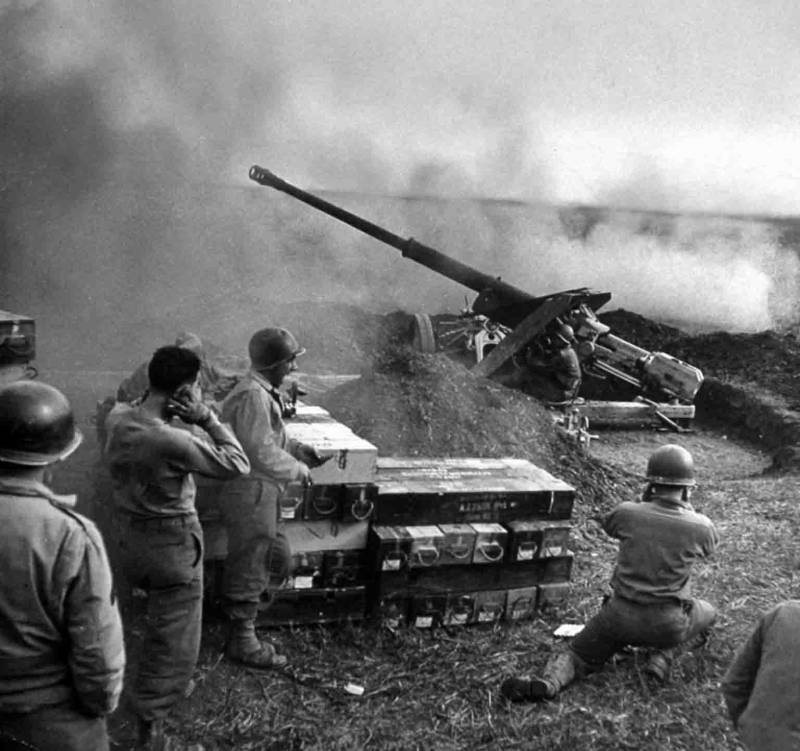
After the division of German trophies, the 88 mm Pak. 43 were available for some time in Denmark, Norway and France. Most of the 88 mm guns were placed in coastal batteries controlling the coastal waters.
128 mm anti-tank guns
It is known that German designers and military personnel were often addicted to gigantomania, which was reflected in the creation of the 128-mm anti-tank gun 12,8 cm PaK. 44 with a barrel length of more than 7 m. Friedrich Krupp AG and Rheinmetall-Borsig AG took part in the competition. At the end of 1943, Friedrich Krupp AG was declared the winner.
From the very beginning, difficulties arose in creating a carriage for such a heavy anti-tank system. The first option was placed on a two-axle “cart”, which was hung on jacks in position. Rubber-coated metal wheels allowed transportation at speeds of up to 35 km/h.
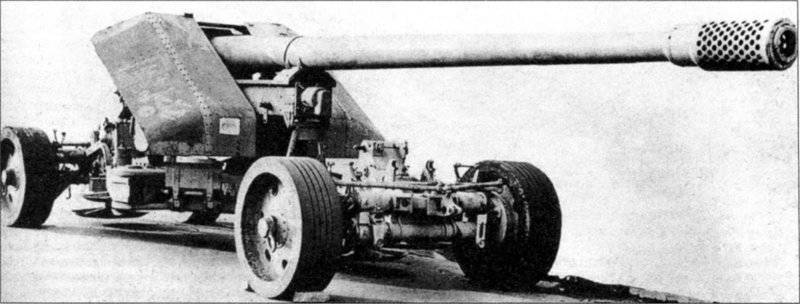
The mass in the stowed position exceeded 10 tons, and the high profile made the gun very noticeable on the ground. The weight in combat position exceeded 9 kg. Due to the large mass of the artillery system, it could only be towed by 300- or 12-ton half-track tractors.
The option proposed by the Rheinmetall-Borsig AG concern was placed on a three-axle carriage with two pairs of wheels in front and one in the rear.

After being transferred to the firing position, the gun rested on a cruciform support and was capable of firing in a 360° sector.
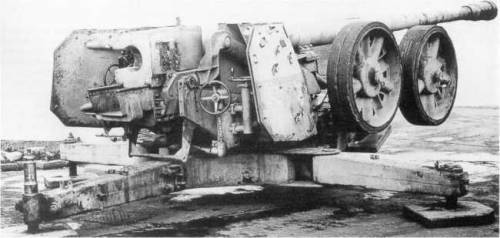
In Pak ammunition. 44 included separate loading shots with an armor-piercing projectile weighing 28,3 kg and a 28-kg high-explosive fragmentation projectile. The 12,8 cm Pz.Gr.40/43 armor-piercing projectile, leaving the barrel at a speed of 930 m/s, penetrated 2 mm armor set at an angle of 000° at a distance of 173 meters. At a distance of 60 m, penetration of 1 mm armor was ensured. A well-trained crew at the training ground could fire 000 rounds per minute; in combat conditions, the rate of fire usually did not exceed 200 rounds per minute.
Some of the 128 mm guns were placed on carriages from the French 155 mm gun Canon de 155 Grande Puissance Filloux model 1917 (this version is known as the 12,8 cm Kanone 81/1) and the Soviet 152 mm howitzer gun model 1937 (12,8, 81 cm Kanone 2/XNUMX).
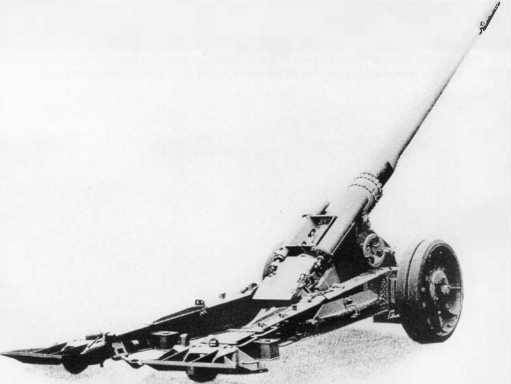
128 mm cannon on the carriage of a Soviet 152 mm howitzer gun ML-20
The mass of the 12,8 cm Kanone 81/2 gun in firing position exceeded 8 kg, and the horizontal firing sector was 300°.
In early November 1944, the formation of a separate anti-tank battery began, armed with 128-mm guns (12,8-cm Kanonen-Batterie), which included six 12,8 cm Kanone 81/1 and 12,8 cm Kanone 81/ 2. By the end of November, four such batteries had been formed.
In total, from April 1944 to January 1945, the Friedrich Krupp AG concern delivered 132 128-mm anti-tank guns. Of these, 80 were used for installation on Jagdtiger self-propelled guns and Maus tanks. The rest were mounted on field carriages and used as anti-tank and hull ones.
Single copies of 128-mm guns were captured by the Red Army and the Allies and after the end of the war they were tested at testing grounds. Despite its heavy weight and huge dimensions, the 12,8 cm PaK. 44 made a great impression on the Soviet command. The technical specifications for post-war heavy Soviet tanks stipulated the condition of withstanding fire from this gun in the frontal projection. The first tank capable of withstanding fire from the PaK. 44, became the experimental Soviet tank IS-7, transferred for testing in the late 1940s.
Продолжение следует ...
Information